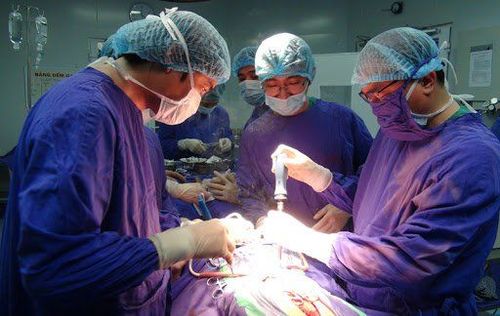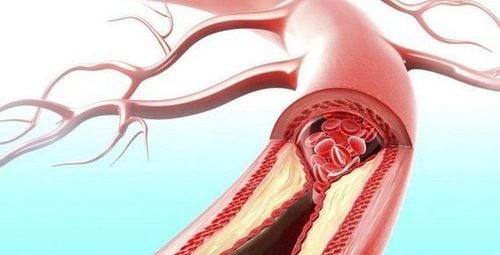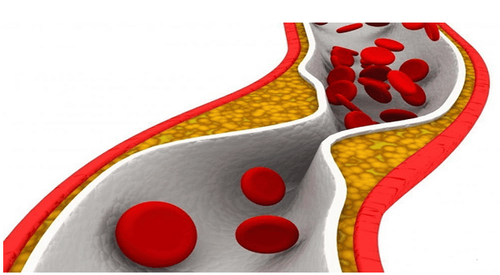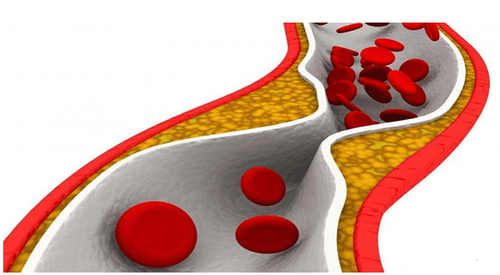This is an automatically translated article.
The article was professionally consulted by Doctor Vo Thanh Nhan - Cardiovascular Center - Vinmec Central Park International General Hospital.Coronary stenosis is manifested by angina pectoris, the risk of dangerous myocardial infarction. To treat coronary artery stenosis, depending on the case, the doctor will prescribe medication, coronary stenting or open heart surgery by aortic bypass procedure
1. Mechanism of coronary stenosis
The coronary arteries, also known as the coronary arteries, are the system of blood vessels that nourish the heart muscle. In patients with coronary artery stenosis, cholesterol in the blood is deposited on the vessel wall, leading to the formation of atherosclerotic plaques that narrow the vessel lumen, resulting in decreased blood flow to the heart muscle cells and causing pain. chest tightness. Coronary stenosis (or coronary insufficiency, coronary insufficiency) increases the risk of myocardial infarction, heart failure, and arrhythmia.Symptoms of coronary stenosis in each patient can be different, but the most typical is angina. Accordingly, the patient feels like the chest is compressed, squeezed, sometimes feels the heart area is stinging, burning uncomfortable. Chest pain can spread to the neck, jaw, shoulders, and arms.
Some patients do not present with chest pain, it is called silent myocardial ischemia. In addition, some other signs of coronary stenosis that you may experience include: shortness of breath, fatigue, bloating, indigestion, nausea...
During treatment, the disease Patients need to follow the non-drug methods as directed by the doctor, including: losing weight (if overweight), adjusting the diet, exercising regularly, and managing stress. This will contribute to a significant improvement in the disease.
Currently, modern medical advances have allowed doctors to choose from many different treatment methods, including treating coronary stenosis with drugs, coronary stents or open heart surgery with dynamic bypass procedures. motherboard .

2. When to use drugs to treat coronary artery stenosis?
Medical treatment with drugs is still the first choice for cases of chronic coronary stenosis.
Commonly used drug groups include:
Blood lipid-lowering drugs: Help reduce blood cholesterol, limit the formation of atheroma. Anticoagulants: Prevent blood clots from forming, reducing the risk of heart attack. Antihypertensive drugs: Reduce the burden on the heart and stabilize the heart rate. Vasodilators: Improve coronary stenosis, quickly relieve symptoms of angina.
3. When should coronary stents be placed?
For the case of coronary artery stenosis over 70% or the patient has unstable angina, even at rest, the doctor will prescribe angioplasty and coronary stenting. The coronary stent acts as a support to help the coronary artery always expand and restore blood flow to the heart muscle.
Coronary stenting is currently a commonly performed cardiovascular intervention, playing an important role in reperfusion of the heart for all conditions of strenuous activity of the patient. The procedure is usually done within 1 hour and most patients are discharged from the hospital within 1-2 days, able to return to a normal rhythm.
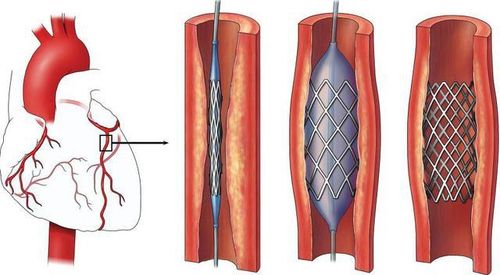
Some patients think that coronary stenting will completely cure coronary artery disease or think that stenting is just a small procedure, so they are subjective. This is a fatal mistake because of the fact that this intervention only addresses the site of coronary blood flow and cannot treat the underlying disease, which is pre-existing atherosclerotic disease. Therefore, blockages may continue to occur elsewhere in the coronary system. Especially when the patient does not comply with the medication prescribed by the doctor, the disease is likely to recur after only 1 to 2 years, even just 6 months after the procedure.
Specifically, after coronary stent implantation, patients with coronary artery stenosis must take antiplatelet drugs, combined with drugs to lower blood pressure, lower blood cholesterol, drugs to treat diabetes if any... Patients need to comply with the indications, take the medicine fully and on time for the prescribed drugs for at least 1 year after the intervention. In addition, it is necessary to periodically re-examine 1 month, 3 months, 6 months and 1 year after stenting. At 1 year later, a stress test should be performed to check myocardial perfusion.
4. When is open heart surgery with aortic bypass?
Aortic bypass is performed when the coronary artery is blocked for a long time or the disease occurs at multiple sites or when the blockage is difficult to place a stent. This is an open-heart surgery method, which completely solves coronary stenosis, but is rarely used because it contains many dangerous risks.
In particular, aortic bypass is often indicated for patients with recurrence after stenting, or stent occlusion causing myocardial infarction, or occurrence of narrowing in surrounding sites, damage to branches. other blood vessels. If not treated promptly with open-heart surgery, the patient's life can be in danger. After 2 such surgeries, the patient's health will take longer to recover, and the endurance will decrease more.
During aortic bypass, the surgeon will use a piece of the patient's own vessel (may be a magnetic artery in the chest, the left and right internal thoracic arteries, the radial artery in the chest). forearm, veins in the thigh and lower leg). This piece of vessel is used as a graft to perform a "bridge", the proximal anastomosis is grafted onto the aorta in the case of a detached graft, thereby allowing blood to flow back to the coronary artery behind the stenosis or stuck.
In other words, the blood supply to the heart will move in a new way, bypassing the coronary stenosis, resolving myocardial ischemia, and the ability to restore contractility can be almost complete if at At the time of surgery, myocardial ischemia was still reversible. Patients can completely return to physical activity as before, the symptoms of coronary artery stenosis will quickly disappear, and the quality of life will be significantly improved.

5. Outstanding advantages when treating coronary stenosis at Vinmec Central Park
Coronary stenting is only effective in the long term if the patient adheres to the doctor's instructions including taking medication. You don't have to have a stent to get better and you don't have to take medicine. In case complications occur after stent placement due to the patient's subjective failure to maintain drug use and abstinence at the request of the doctor or due to adverse effects from outside causing blockage of blood vessels... Such cases require aortic bypass surgery and require consultation from specialists as well as physicians with experience in the cardiology department.
Vinmec Central Park International General Hospital (HCMC) applies a full-service cardiovascular disease treatment model. This is a treatment modality being carried out at leading Cardiovascular Centers in the US and many other developed countries such as Mayo Clinic, Cleveland Clinic, Pennsylvania....
Cardiovascular Package Program (BUNDLE) PAYMENT ) will be applied with 4 techniques:
TAVI intervention Coronary intervention stenting Aortic bypass surgery Ventricular septal surgery The doctor will check and confirm which technique the patient needs to apply in 4 techniques above for treatment, then will be consulted to choose and sign a contract to use the appropriate package. The contract includes the treatment method, length of hospital stay, number of follow-up visits and a fixed cost that the patient has to pay for the duration of the treatment.
Package treatment model is one of the activities to realize the policy of "Patient is the center" at Vinmec International General Hospital. The outstanding advantages of the full-service cardiovascular treatment model at Vinmec Central Park include:
Multi-specialty treatment: Patients will have a comprehensive and thorough treatment plan by a multi-specialty team, coordinating The treatment regimen is standardized according to the standards of the prestigious Cardiovascular Associations in the world. Patients have direct access to the most appropriate and optimal regimen, avoiding the need to test many methods. Different treatments are costly or reduce the effectiveness of treatment Increase recovery, reduce hospital stay Peace of mind about the treatment plan and proactive about treatment costs Vinmec Central Park Heart Center is one of key centers of Vinmec Health System, gaining JCI global certification. The center is invested with modern equipment and well-trained human resources, including many leading experts in the field of Cardiology such as:
Professor, Doctor, Doctor Vo Thanh Nhan: First expert Vietnam's pioneer in percutaneous aortic valve replacement (TAVI); pioneer in the implementation of new and specialized cardiovascular techniques: MitraClip, StentGraft... Dr., Doctor Nguyen Luong Tan : Expert in adult and pediatric cardiothoracic surgery. The doctor is well-trained in the country and many centers have the world's leading medical background such as: France, Australia... Master, Doctor Nguyen Duc Hien: Has more than 12 years of experience in the field of cardiology especially especially Cardiovascular and thoracic surgery.... Vinmec Central Park Heart Center has successfully treated over 98% of cases of TAVI intervention, open heart surgery, painless open heart surgery by combination ESP technique, effective even with severe and elderly cases. Vinmec Central Park is also the first hospital in Vietnam to be recognized as an independent American standard TAVI intervention center.
To find out more information about the BUNDLE PAYMENT Cardiovascular Treatment Package, you can contact the call center or register for an online examination at the website.
Please dial HOTLINE for more information or register for an appointment HERE. Download MyVinmec app to make appointments faster and to manage your bookings easily.






